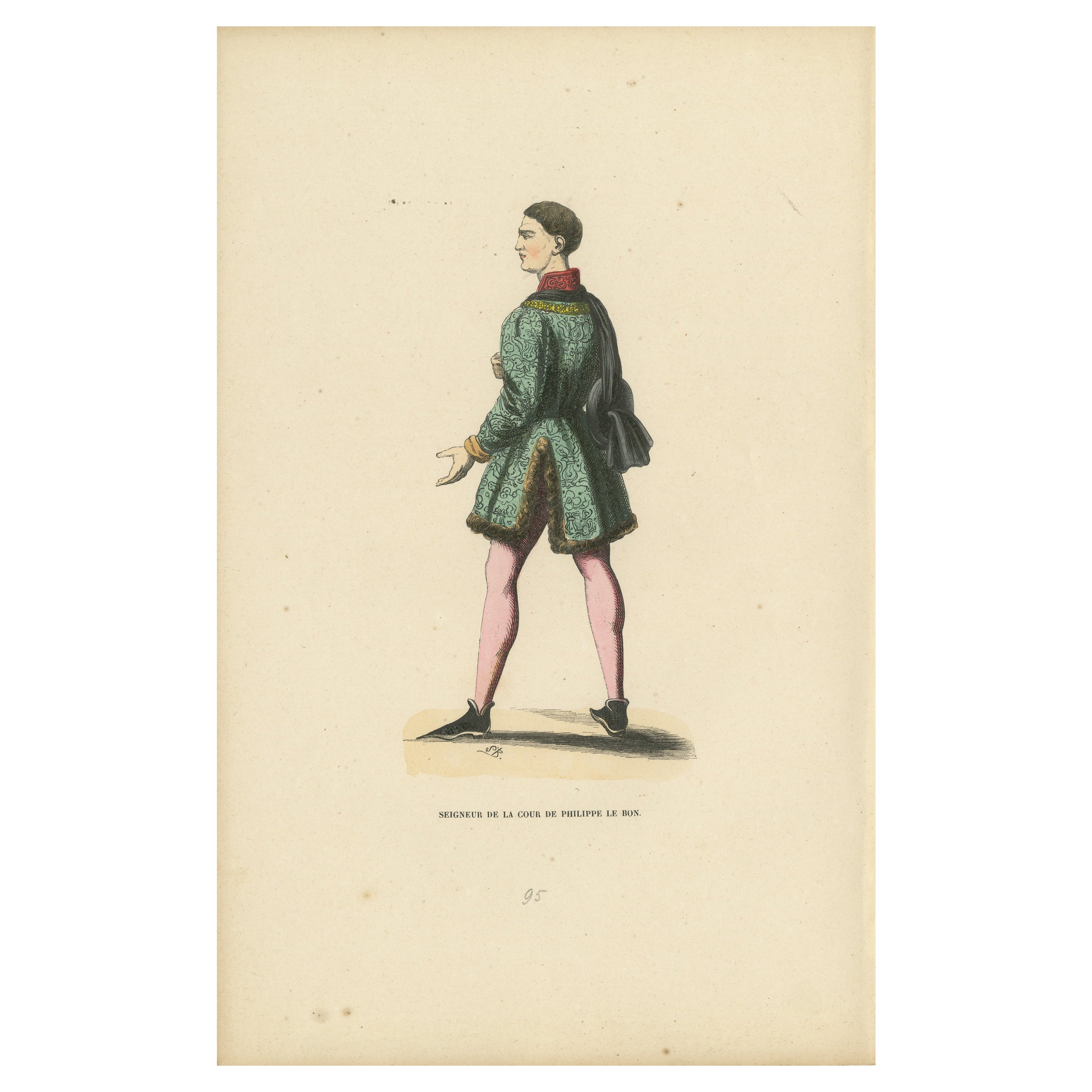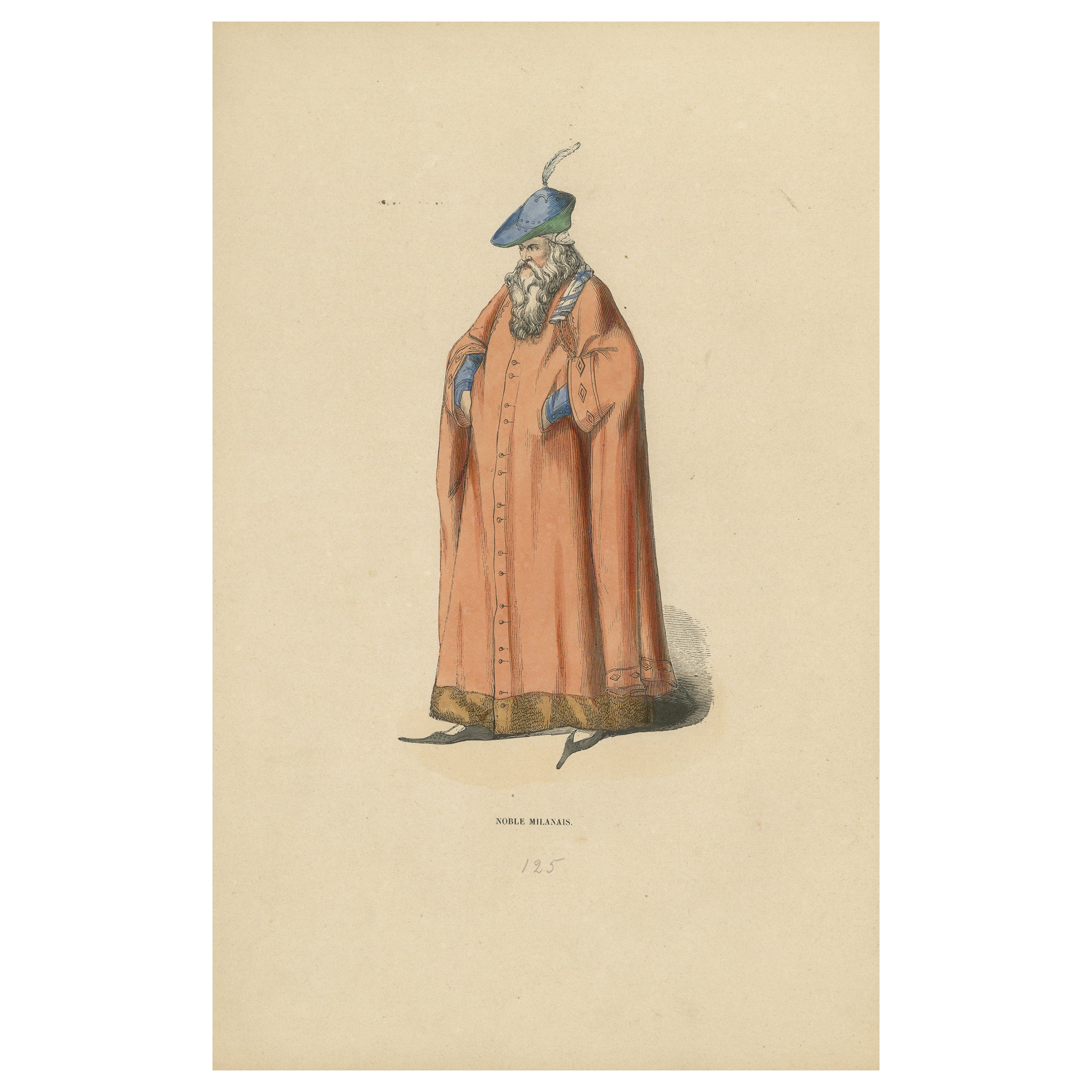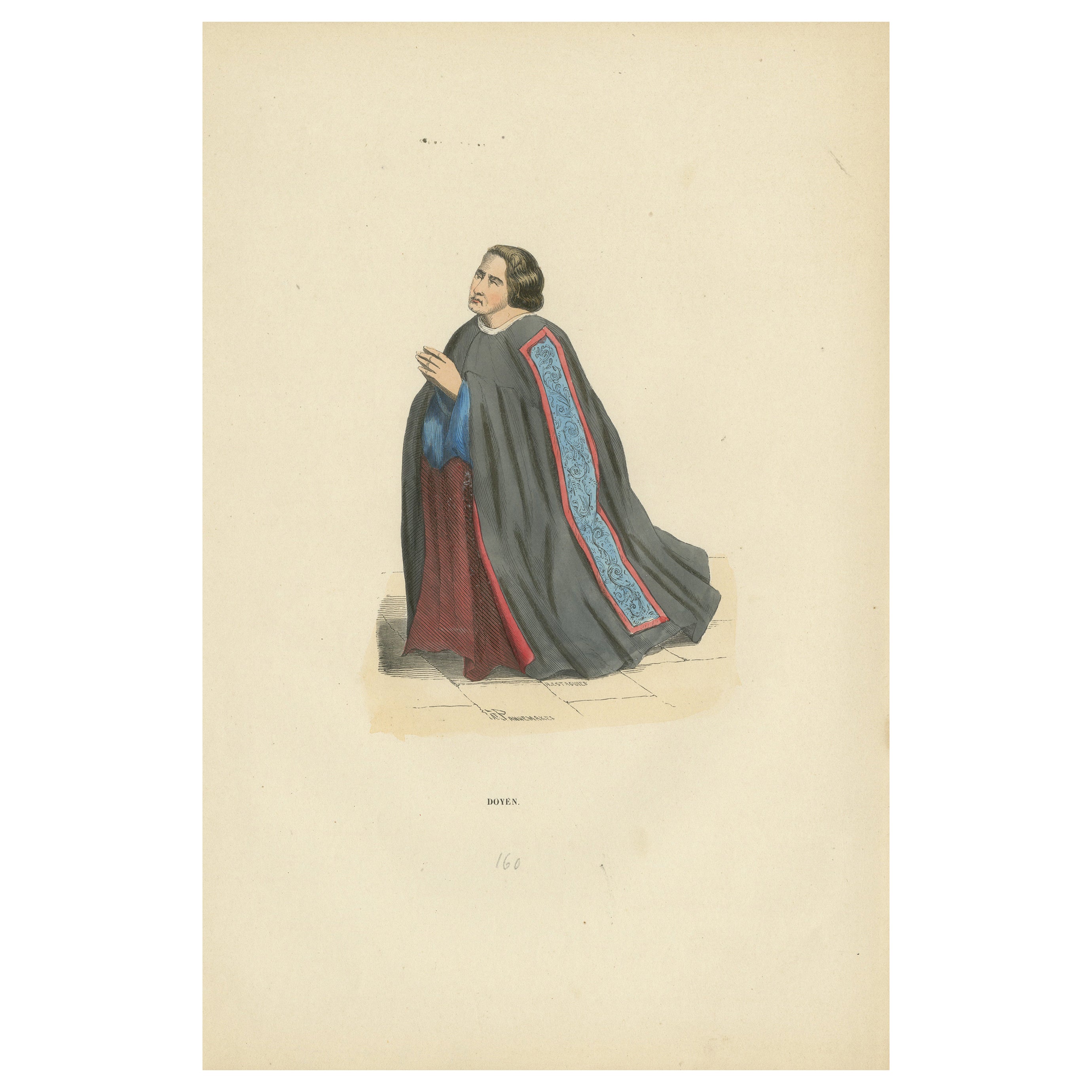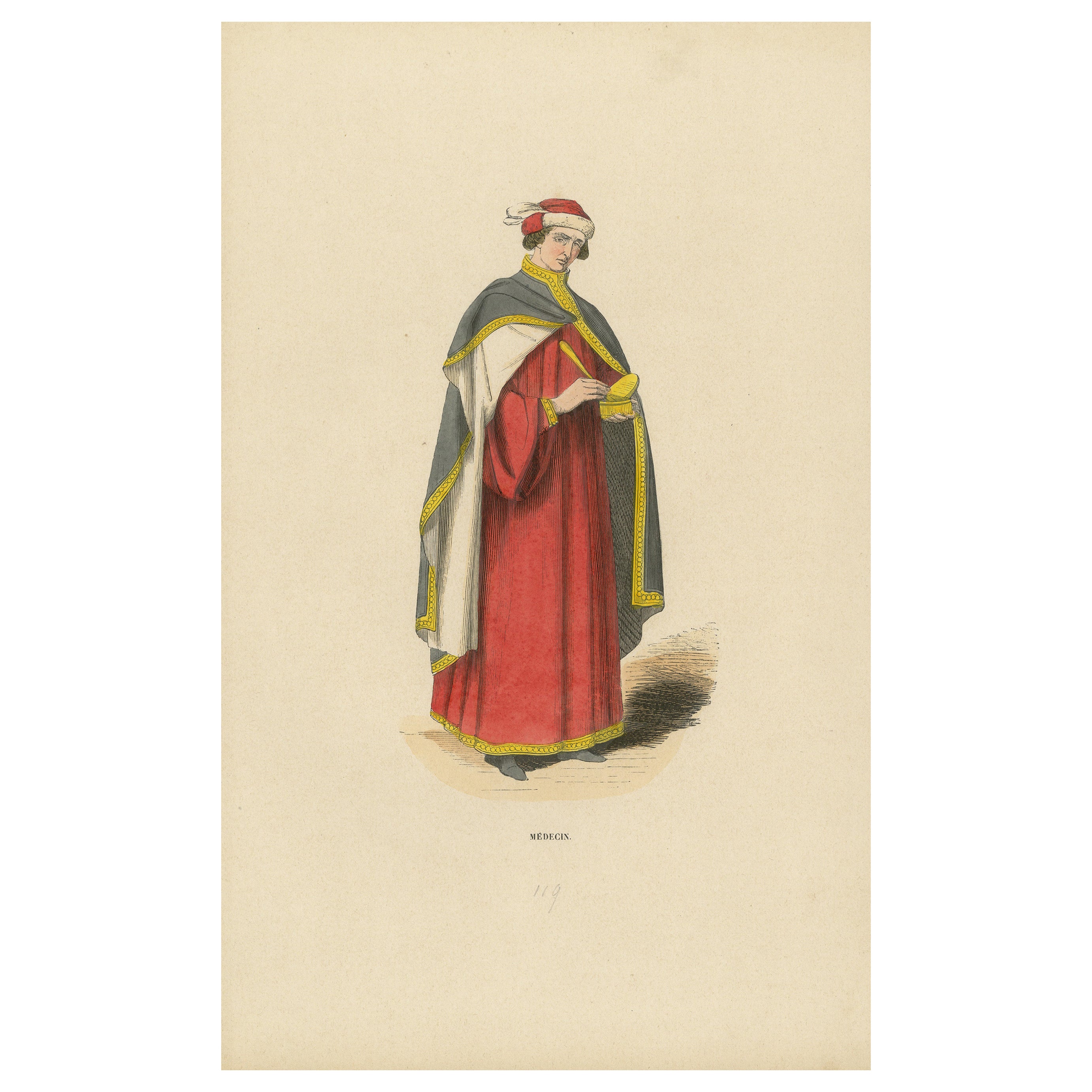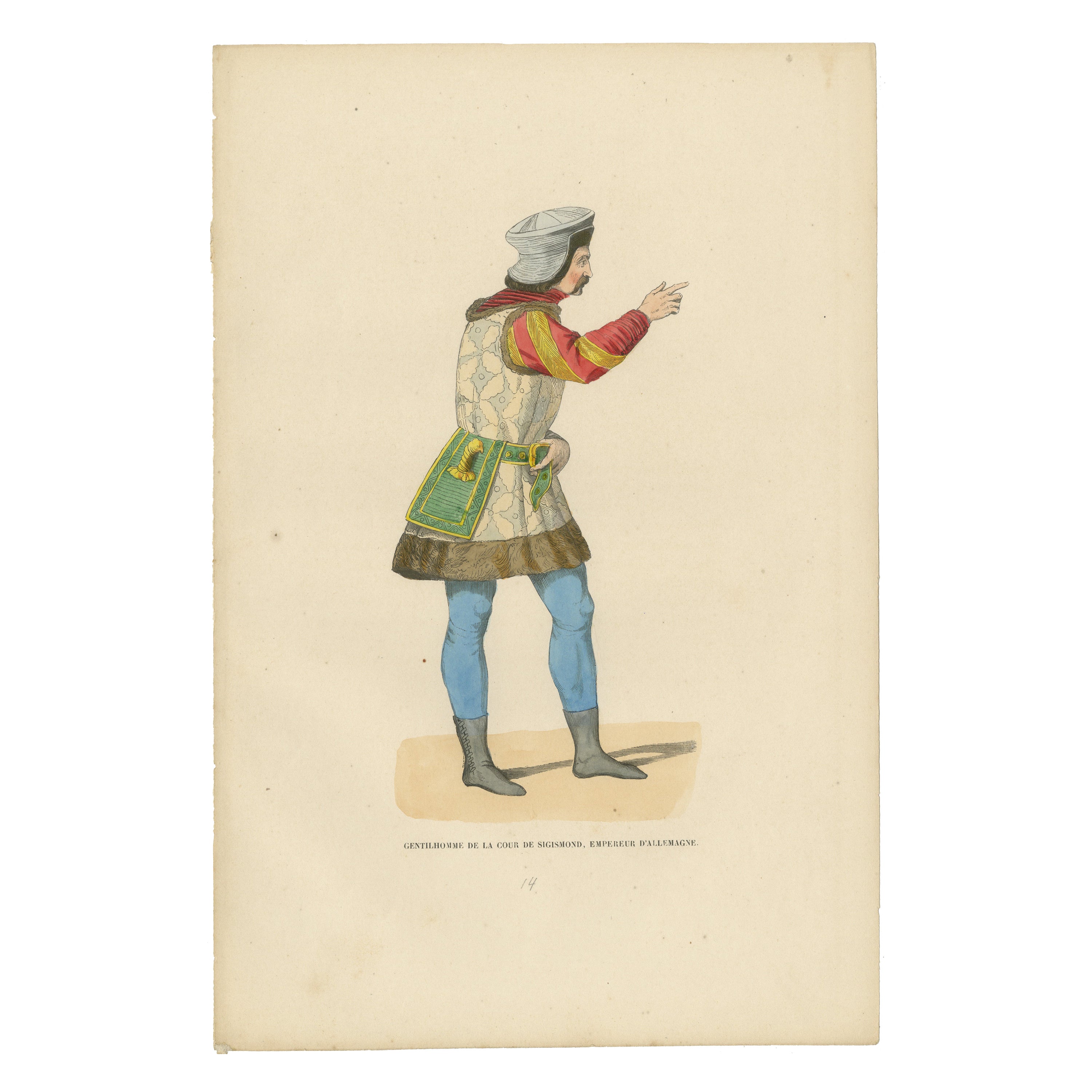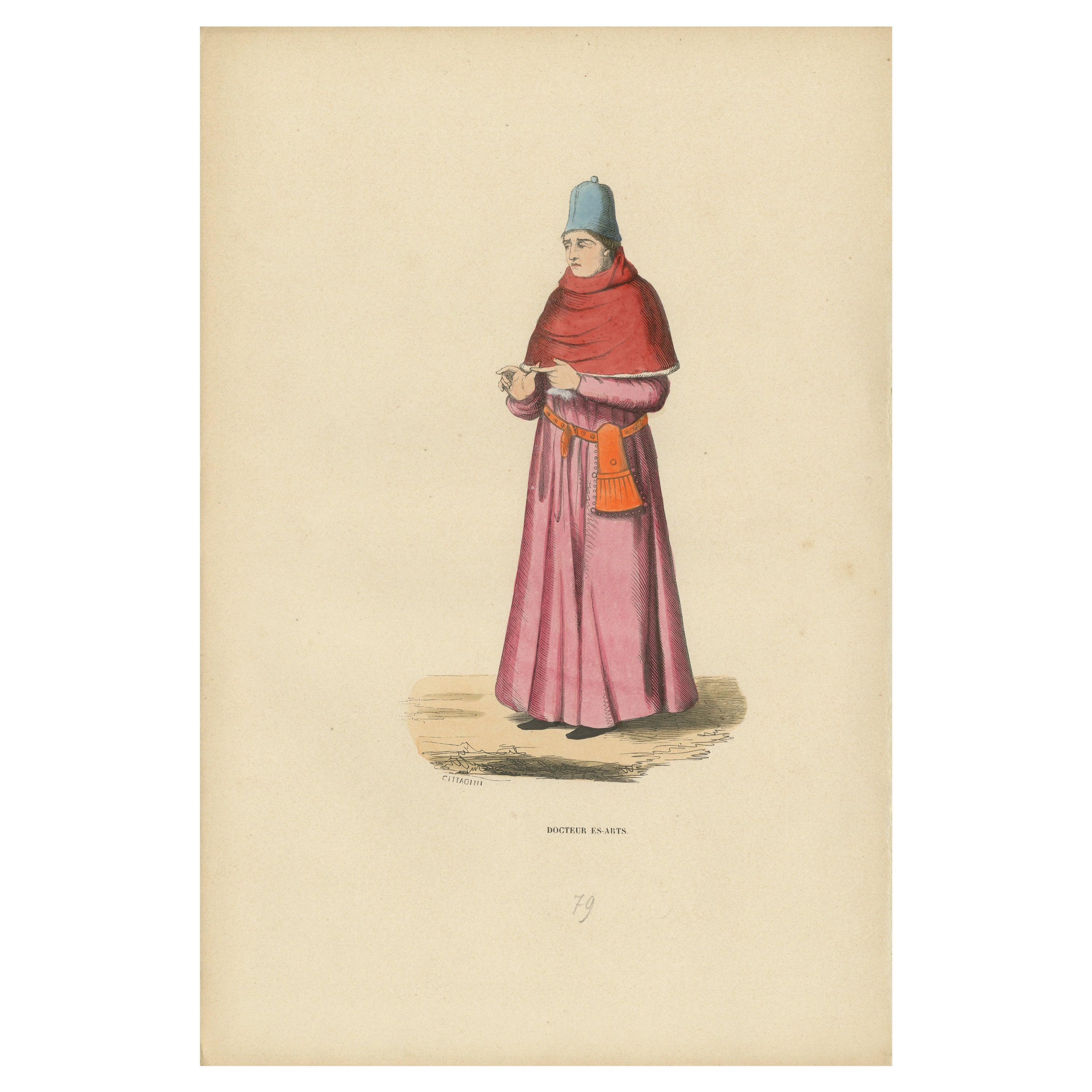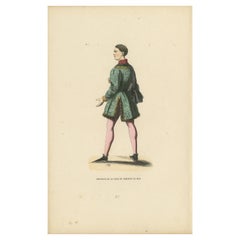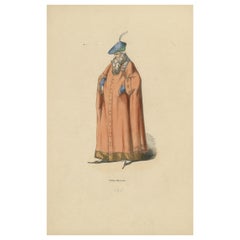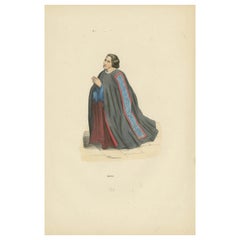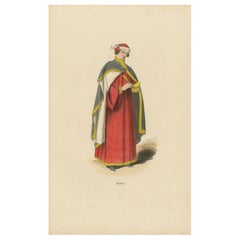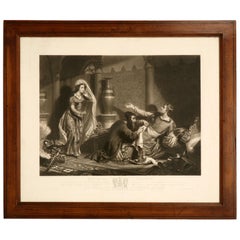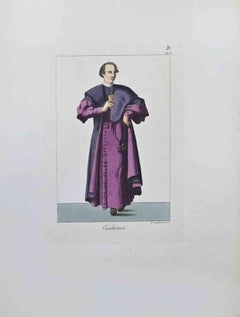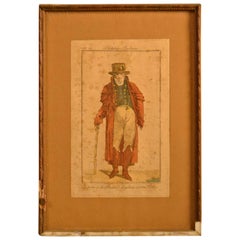Items Similar to Aristocratic Elegance: A Lord of Richard II's Court, Original Old Print of 1847
Want more images or videos?
Request additional images or videos from the seller
1 of 6
Aristocratic Elegance: A Lord of Richard II's Court, Original Old Print of 1847
$153.73
$192.1620% Off
£113.22
£141.5220% Off
€128
€16020% Off
CA$209.13
CA$261.4220% Off
A$232.39
A$290.4920% Off
CHF 121.78
CHF 152.2220% Off
MX$2,849.88
MX$3,562.3520% Off
NOK 1,553.18
NOK 1,941.4820% Off
SEK 1,461.18
SEK 1,826.4720% Off
DKK 974.44
DKK 1,218.0620% Off
Shipping
Retrieving quote...The 1stDibs Promise:
Authenticity Guarantee,
Money-Back Guarantee,
24-Hour Cancellation
About the Item
Title: "Aristocratic Elegance: A Lord of Richard II's Court in 'Costume du Moyen Âge'"
Description: This lithograph from "Costume du Moyen Âge," dated 1847, presents a nobleman from the court of King Richard II. The figure is robed in a long, deep red gown, which is ornamented with a pattern of golden circles, each possibly representing a coin or noble emblem, signifying wealth and status. The gown is lined with a bright yellow border that is punctuated with blue, creating a striking contrast against the red.
The nobleman is depicted in profile, with his head turned towards the viewer, offering a glimpse of his facial features that are marked by a contemplative expression. He wears a white headdress that wraps around his head and chin, suggesting a style that denotes his high social rank. In his hands, he holds what appears to be a piece of fabric or a garment, indicating a moment of quietude or preparation for an event.
The simplicity of the background focuses attention on the rich colors and textures of the nobleman's attire. The image captures the refined aesthetic and decorum that would be expected at the court of Richard II, a time known for its attention to fashion and the arts.
This lithograph not only portrays the individual style of a nobleman but also serves as an illustrative record of the sartorial standards of the English court in the late 14th century. It reflects the era's keen interest in detailed, luxurious clothing as a symbol of status and identity, providing an insightful look into the visual culture of the medieval nobility.
The colors have a nice glow over them. Historically, egg whites, known as glair, and sometimes egg yolk were indeed used in illumination and painting, particularly in manuscripts, to give colors a brighter appearance and to add a sheen or gloss to the work. This technique was quite common during the Middle Ages and into the Renaissance.
Egg whites can be applied as a varnish over pigments to enhance their brightness and to protect the colors. This application could make the colors appear more vivid and also add a slight glossy sheen to the surface of the image.
Egg yolk, on the other hand, was commonly used as a binding agent in paint. It forms the basis of tempera paint, a medium that was widely used before the advent of oil painting. Egg yolk helps to create a durable and long-lasting color that adheres well to various surfaces.
In the context of the print from 1847, it's less likely that egg whites or yolks were used directly on the print, as by that time, commercial printing processes would have been more advanced and less reliant on such manual methods. However, if this print is a representation of an earlier style or is meant to mimic the appearance of hand-painted manuscripts, the original artists might have employed techniques or materials that gave a similar effect to those achieved with egg-based binders and varnishes.
- Dimensions:Height: 10.63 in (27 cm)Width: 7.09 in (18 cm)Depth: 0 in (0.02 mm)
- Materials and Techniques:
- Period:
- Date of Manufacture:1847
- Condition:Good. Overal light toning and light soiling but the image itself clean and hand-colored almost 200 years ago and still in expliciet colors. Aged paper with typically warm, yellowish-brown hue, mostly around the edges. Study the images carefully.
- Seller Location:Langweer, NL
- Reference Number:Seller: BG-13635-1121stDibs: LU3054337927552
About the Seller
5.0
Recognized Seller
These prestigious sellers are industry leaders and represent the highest echelon for item quality and design.
Platinum Seller
Premium sellers with a 4.7+ rating and 24-hour response times
Established in 2009
1stDibs seller since 2017
2,494 sales on 1stDibs
Typical response time: 1 hour
- ShippingRetrieving quote...Shipping from: Langweer, Netherlands
- Return Policy
Authenticity Guarantee
In the unlikely event there’s an issue with an item’s authenticity, contact us within 1 year for a full refund. DetailsMoney-Back Guarantee
If your item is not as described, is damaged in transit, or does not arrive, contact us within 7 days for a full refund. Details24-Hour Cancellation
You have a 24-hour grace period in which to reconsider your purchase, with no questions asked.Vetted Professional Sellers
Our world-class sellers must adhere to strict standards for service and quality, maintaining the integrity of our listings.Price-Match Guarantee
If you find that a seller listed the same item for a lower price elsewhere, we’ll match it.Trusted Global Delivery
Our best-in-class carrier network provides specialized shipping options worldwide, including custom delivery.More From This Seller
View AllLord of the Court of Philip the Good, Engraved and Published in 1847
Located in Langweer, NL
The image presents a nobleman of the court of Philippe le Bon (Philip the Good), Duke of Burgundy. The nobleman stands in profile, gazing into the distance, with an air of contemplat...
Category
Antique 1840s Prints
Materials
Paper
$115 Sale Price
20% Off
The Stature of a Milanese Noble: An Lithographic Artistic Depiction, 1847
Located in Langweer, NL
Title: "The Stature of a Milanese Noble: An Artistic Depiction from 'Costume du Moyen Âge'"
Description: This finely detailed lithograph is part of the 1847 seminal work "Costume du Moyen Âge," which portrays a Milanese nobleman, attired in the fashion of the Middle Ages. The nobleman stands in a dignified pose, with a slight turn to the side that suggests movement or the commencement of an address. His garment is a robust, terracotta-hued robe, which falls in heavy folds to the ground, indicating the weight and quality of the fabric. The robe features elegant blue cuffs and a blue collar, which provide a contrast to the warm primary color and are adorned with diamond-shaped embellishments, implying a subtle yet unmistakable wealth.
Atop his head sits a distinctive chapeau with a jaunty feather, adding a touch of personal flair to his ensemble. This hat, along with his full, neatly groomed beard, contributes to the air of wisdom and experience that the nobleman exudes. His expression is one of contemplation and sagacity, with eyes that appear to be observing or assessing the scene before him.
As in other plates from the collection, the background is left intentionally plain, directing the viewer’s focus to the subject and his elaborate attire. This lithograph not only captures the fashion and dignity of a nobleman from Milan but also serves as a cultural and historical record, revealing the meticulous attention to detail in costume design and social hierarchy of the time. The lithograph serves as a visual study of the mores and attire of the period, crafted with reverence for the historical accuracy and an appreciation for the aesthetics of medieval clothing...
Category
Antique 1840s Prints
Materials
Paper
$134 Sale Price
20% Off
The Revered Doyen: A Portrait of Venerable Leadership, Lithograph Published 1847
Located in Langweer, NL
This original antique lithograph for sale depicts a historical figure known as a "Doyen," which typically refers to the senior member of a body or group. This individual is portrayed...
Category
Antique 1840s Prints
Materials
Paper
$124 Sale Price
20% Off
Attire of a Medieval Scholar: The Learned Physician of the Middle Ages, 1847
Located in Langweer, NL
Title: "Attire of a Medieval Scholar: The Learned Physician of the Middle Ages"
This hand-colored lithograph, titled "Médecin" in the original French, is a detailed portrayal of a m...
Category
Antique 1840s Prints
Materials
Paper
$144 Sale Price
20% Off
Courtly Splendor: A Nobleman at Emperor Sigismund's Court, 1847
Located in Langweer, NL
The image depicts a man identified as a "Gentilhomme de la cour de Sigismond, empereur d'Allemagne," which translates to "Gentleman of the court of Sigismund, Emperor of Germany."
This individual is portrayed in a profile stance, dressed in attire that is indicative of the high-status courtiers during the time of Emperor Sigismund, who reigned in the early 15th century. He is wearing a turban-like headgear, which reflects the influence of Eastern fashion on European court attire, possibly due to the Ottoman influence or the general exchange of culture during the Crusades and subsequent interactions.
His doublet is richly patterned and he has puffed sleeves in red, which were fashionable among the nobility during the period. The garment is accented with a decorative belt that holds what appears to be a purse or a pouch. He also sports tight blue hose and pointed shoes, which complete the ensemble typical of a nobleman or a high-ranking court official in the Holy Roman Empire.
Egg whites can be applied as a varnish over pigments to enhance their brightness and to protect the colors. This application could make the colors appear more vivid and also add a slight glossy sheen to the surface of the image.
Egg yolk, on the other hand, was commonly used as a binding agent in paint. It forms the basis of tempera paint, a medium that was widely used before the advent of oil painting. Egg yolk helps to create a durable and long-lasting color that adheres well to various surfaces.
In the context of the print from 1847, it's less likely that egg whites or yolks were used directly on the print, as by that time, commercial printing processes would have been more advanced and less reliant on such manual methods. However, if this print is a representation of an earlier style or is meant to mimic the appearance of hand-painted manuscripts...
Category
Antique 1840s Prints
Materials
Paper
$153 Sale Price
20% Off
Scholar of the Arts: The Medieval Academic, 1847
Located in Langweer, NL
Title: "Scholar of the Arts: The Medieval Academic"
Description: This print illustrates a learned individual, likely a doctor of the arts or a scholar, from the medieval period. The...
Category
Antique 1840s Prints
Materials
Paper
$115 Sale Price
20% Off
You May Also Like
Le Impératrice Eugénie Lithograph, c.1850s
Located in Savannah, GA
A large hand-colored lithograph entitled “Le Impératrice, Compiegne,” after the painting by Jean Victor Adam (1801-1866), circa 1850s. Depicted is the Empress Eugénie de Montijo, wi...
Category
Antique Mid-19th Century French Other Prints
Materials
Glass, Wood, Paper
c.1830 Exquisite Antique English Etching Artist Proof
Located in Chicago, IL
English etching artist proof. The bottom reads as follows:
Printed by Henry Fradelle and engraved by Thomas Lupton.
Rebecca and Ivanhoe
AS THE WOUNDED KNIGHT WAS ABOUT TO ADDRESS THIS FAIR APPARITION SHE IMPOSED SILENCE BY PLACING HER SLENDER FINGER UPON HER RUBY LIPS...
Category
Antique 19th Century English Romantic Prints
Materials
Paper
"Caudatario" - Etching by Giuseppe Capparoni - 1827
Located in Roma, IT
"Caudatario" is an Artwork realized in 1827 by the Engraver, Giuseppe Capparoni (Rome 1800- 1879).
Etching hand colored on ivory paper. Signed on plate on the right margin.
The a...
Category
1820s Modern Portrait Prints
Materials
Etching
18th Century, Framed Fashion Engraving
Located in Vista, CA
18th Century framed fashion engraving. Gilding on frame is damaged (see picture).
Category
Antique 18th Century and Earlier French Drawings
Materials
Giltwood, Glass
Antique English Prints by Joseph Nash
By Joseph Nash
Located in Alessandria, Piemonte
ST/218 - 3 - Entrance --- Two colors lithography in black and sepia.
Author: Joseph Nash, famous British painter, member of the Gothic Revival Group. In 1838 he published the Revival Lithographic Collection "Medieval Architecture...
Category
Antique Mid-19th Century English Other Prints
Materials
Paper
$480 / set
Graphic, Russel's History of England, Edward, Prince of Wales
Located in Opole, PL
We present you one of the fourteen graphics from the series, depicting the history of England.
The graphic is from Russel’s New and Authentic History of England, published in the 18th century.
The author of the drawing is Wale Samuel (1720-1786), and the template was made by Debroche.
This piece of art is entitled: “Edward, Prince of Wales arrested by the Duke of Clarence and others on the Signal given by Edward IV...
Category
Early 20th Century European Prints
Materials
Paper
$192 Sale Price
20% Off
More Ways To Browse
Antique Silver Boxes Repousse
Antique Storm Glass
Antique Thimbles
Antique Victorian Grandfather Clock
Antique Wooden Swan
Art Deco Bed Frame Queen
Art Deco Buffet Mirror
Art Deco Desk Statue
Art Deco Full Bed
Art Deco Glass Shelving
Astronomical Clock
Baker Dining Buffet
Baker Neoclassical Dining
Baker New World Collection
Baroque Headboard
Bear Bookends
Bi Discs
Birds Of Paradise China
